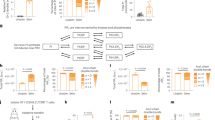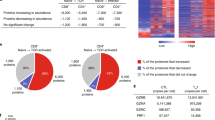Abstract
Phosphatidylinositol-3-OH kinase (PI(3)K) and the nutrient sensor mTOR are evolutionarily conserved regulators of cell metabolism. Here we show that PI(3)K and mTOR determined the repertoire of adhesion and chemokine receptors expressed by T lymphocytes. The key lymph node–homing receptors CD62L (L-selectin) and CCR7 were highly expressed on naive T lymphocytes but were downregulated after immune activation. CD62L downregulation occurred through ectodomain proteolysis and suppression of gene transcription. The p110δ subunit of PI(3)K controlled CD62L proteolysis through mitogen-activated protein kinases, whereas control of CD62L transcription by p110δ was mediated by mTOR through regulation of the transcription factor KLF2. PI(3)K-mTOR nutrient-sensing pathways also determined expression of the chemokine receptor CCR7 and regulated lymphocyte trafficking in vivo. Hence, lymphocytes use PI(3)K and mTOR to match metabolism and trafficking.
This is a preview of subscription content, access via your institution
Access options
Subscribe to this journal
Receive 12 print issues and online access
$209.00 per year
only $17.42 per issue
Buy this article
- Purchase on Springer Link
- Instant access to full article PDF
Prices may be subject to local taxes which are calculated during checkout






Similar content being viewed by others
Change history
19 May 2008
In the version of this article initially published, the key for Figure 5b is incorrect. The black bars should be ‘CD4+ SP’ and the gray bars should be ’DP’. The error has been corrected in the HTML and PDF versions of the article.
References
Fruman, D.A. Phosphoinositide 3-kinase and its targets in B-cell and T-cell signaling. Curr. Opin. Immunol. 16, 314–320 (2004).
Costello, P.S., Gallagher, M. & Cantrell, D.A. Sustained and dynamic inositol lipid metabolism inside and outside the immunological synapse. Nat. Immunol. 3, 1082–1089 (2002).
Garcon, F. et al. CD28 provides T-cell costimulation and enhances PI3K activity at the immune synapse independently of its capacity to interact with the p85/p110 heterodimer. Blood 111, 1464–1471 (2008).
Harriague, J. & Bismuth, G. Imaging antigen-induced PI3K activation in T cells. Nat. Immunol. 3, 1090–1096 (2002).
Jones, R.G. & Thompson, C.B. Revving the engine: signal transduction fuels T cell activation. Immunity 27, 173–178 (2007).
Reif, K., Nobes, C.D., Thomas, G., Hall, A. & Cantrell, D.A. Phosphatidylinositol 3-kinase signals activate a selective subset of Rac/Rho-dependent effector pathways. Curr. Biol. 6, 1445–1455 (1996).
Reif, K. et al. Cutting edge: differential roles for phosphoinositide 3-kinases, p110γ and p110δ, in lymphocyte chemotaxis and homing. J. Immunol. 173, 2236–2240 (2004).
Ward, S.G. T lymphocytes on the move: chemokines, PI 3-kinase and beyond. Trends Immunol. 27, 80–87 (2006).
Matheu, M.P., Deane, J.A., Parker, I., Fruman, D.A. & Cahalan, M.D. Class IA phosphoinositide 3-kinase modulates basal lymphocyte motility in the lymph node. J. Immunol. 179, 2261–2269 (2007).
Asperti-Boursin, F., Real, E., Bismuth, G., Trautmann, A. & Donnadieu, E. CCR7 ligands control basal T cell motility within lymph node slices in a phosphoinositide 3-kinase-independent manner. J. Exp. Med. 204, 1167–1179 (2007).
Cyster, J.G. Chemokines, sphingosine-1-phosphate, and cell migration in secondary lymphoid organs. Annu. Rev. Immunol. 23, 127–159 (2005).
Mora, J.R. & von Andrian, U.H. T-cell homing specificity and plasticity: new concepts and future challenges. Trends Immunol. 27, 235–243 (2006).
Springer, T.A. Traffic signals for lymphocyte recirculation and leukocyte emigration: the multistep paradigm. Cell 76, 301–314 (1994).
Arbones, M.L. et al. Lymphocyte homing and leukocyte rolling and migration are impaired in L-selectin-deficient mice. Immunity 1, 247–260 (1994).
Tang, M.L., Steeber, D.A., Zhang, X.Q. & Tedder, T.F. Intrinsic differences in L-selectin expression levels affect T and B lymphocyte subset-specific recirculation pathways. J. Immunol. 160, 5113–5121 (1998).
Lefrancois, L. Development, trafficking, and function of memory T-cell subsets. Immunol. Rev. 211, 93–103 (2006).
Jung, T.M., Gallatin, W.M., Weissman, I.L. & Dailey, M.O. Down-regulation of homing receptors after T cell activation. J. Immunol. 141, 4110–4117 (1988).
Chao, C.C., Jensen, R. & Dailey, M.O. Mechanisms of L-selectin regulation by activated T cells. J. Immunol. 159, 1686–1694 (1997).
Preece, G., Murphy, G. & Ager, A. Metalloproteinase-mediated regulation of L-selectin levels on leucocytes. J. Biol. Chem. 271, 11634–11640 (1996).
Ley, K. & Kansas, G.S. Selectins in T-cell recruitment to non-lymphoid tissues and sites of inflammation. Nat. Rev. Immunol. 4, 325–335 (2004).
Venturi, G.M. et al. Leukocyte migration is regulated by L-selectin endoproteolytic release. Immunity 19, 713–724 (2003).
Kaech, S.M., Hemby, S., Kersh, E. & Ahmed, R. Molecular and functional profiling of memory CD8 T cell differentiation. Cell 111, 837–851 (2002).
Manjunath, N. et al. Effector differentiation is not prerequisite for generation of memory cytotoxic T lymphocytes. J. Clin. Invest. 108, 871–878 (2001).
Weninger, W., Crowley, M.A., Manjunath, N. & von Andrian, U.H. Migratory properties of naive, effector, and memory CD8+ T cells. J. Exp. Med. 194, 953–966 (2001).
Cornish, G.H., Sinclair, L.V. & Cantrell, D.A. Differential regulation of T-cell growth by IL-2 and IL-15. Blood 108, 600–608 (2006).
Galkina, E. et al. L-selectin shedding does not regulate constitutive T cell trafficking but controls the migration pathways of antigen-activated T lymphocytes. J. Exp. Med. 198, 1323–1335 (2003).
Li, Y., Brazzell, J., Herrera, A. & Walcheck, B. ADAM17 deficiency by mature neutrophils has differential effects on L-selectin shedding. Blood 108, 2275–2279 (2006).
Vanhaesebroeck, B., Ali, K., Bilancio, A., Geering, B. & Foukas, L.C. Signalling by PI3K isoforms: insights from gene-targeted mice. Trends Biochem. Sci. 30, 194–204 (2005).
Okkenhaug, K. et al. Impaired B and T cell antigen receptor signaling in p110δ PI 3-kinase mutant mice. Science 297, 1031–1034 (2002).
Okkenhaug, K. et al. The p110δ isoform of phosphoinositide 3-kinase controls clonal expansion and differentiation of Th cells. J. Immunol. 177, 5122–5128 (2006).
Kelly, A.P. et al. Notch-induced T cell development requires phosphoinositide-dependent kinase 1. EMBO J. 26, 3441–3450 (2007).
Fan, H. & Derynck, R. Ectodomain shedding of TGF-α and other transmembrane proteins is induced by receptor tyrosine kinase activation and MAP kinase signaling cascades. EMBO J. 18, 6962–6972 (1999).
Borroto, A. et al. Impaired trafficking and activation of tumor necrosis factor-α-converting enzyme in cell mutants defective in protein ectodomain shedding. J. Biol. Chem. 278, 25933–25939 (2003).
Diaz-Rodriguez, E., Montero, J.C., Esparis-Ogando, A., Yuste, L. & Pandiella, A. Extracellular signal-regulated kinase phosphorylates tumor necrosis factor α-converting enzyme at threonine 735: a potential role in regulated shedding. Mol. Biol. Cell 13, 2031–2044 (2002).
Soond, S.M., Everson, B., Riches, D.W. & Murphy, G. ERK-mediated phosphorylation of Thr735 in TNFα-converting enzyme and its potential role in TACE protein trafficking. J. Cell Sci. 118, 2371–2380 (2005).
Fingar, D.C. & Blenis, J. Target of rapamycin (TOR): an integrator of nutrient and growth factor signals and coordinator of cell growth and cell cycle progression. Oncogene 23, 3151–3171 (2004).
Sebzda, E., Zou, Z., Lee, J.S., Wang, T. & Kahn, M.L. Transcription factor KLF2 regulates the migration of naive T cells by restricting chemokine receptor expression patterns. Nat. Immunol. 9, 292–300 (2008).
Bai, A., Hu, H., Yeung, M. & Chen, J. Kruppel-like factor 2 controls T cell trafficking by activating L-selectin (CD62L) and sphingosine-1-phosphate receptor 1 transcription. J. Immunol. 178, 7632–7639 (2007).
Carlson, C.M. et al. Kruppel-like factor 2 regulates thymocyte and T-cell migration. Nature 442, 299–302 (2006).
Hagenbeek, T.J. et al. The loss of PTEN allows TCR αβ lineage thymocytes to bypass IL-7 and pre-TCR-mediated signaling. J. Exp. Med. 200, 883–894 (2004).
Unsoeld, H., Voehringer, D., Krautwald, S. & Pircher, H. Constitutive expression of CCR7 directs effector CD8 T cells into the splenic white pulp and impairs functional activity. J. Immunol. 173, 3013–3019 (2004).
Venturi, G.M., Conway, R.M., Steeber, D.A. & Tedder, T.F. CD25+CD4+ regulatory T cell migration requires L-selectin expression: L-selectin transcriptional regulation balances constitutive receptor turnover. J. Immunol. 178, 291–300 (2007).
Richards, H., Longhi, M.P., Wright, K., Gallimore, A. & Ager, A. CD62L down-regulation does not affect memory T cell distribution but failure to shed compromises anti-viral Immunity. J. Immunol. 180, 198–206 (2008).
Sarbassov, D.D., Ali, S.M. & Sabatini, D.M. Growing roles for the mTOR pathway. Curr. Opin. Cell Biol. 17, 596–603 (2005).
Battaglia, M., Stabilini, A. & Roncarolo, M.G. Rapamycin selectively expands CD4+CD25+FoxP3+ regulatory T cells. Blood 105, 4743–4748 (2005).
Zheng, X.X. et al. Favorably tipping the balance between cytopathic and regulatory T cells to create transplantation tolerance. Immunity 19, 503–514 (2003).
Guarda, G. et al. L-selectin-negative CCR7− effector and memory CD8+ T cells enter reactive lymph nodes and kill dendritic cells. Nat. Immunol. 8, 743–752 (2007).
Pircher, H., Burki, K., Lang, R., Hengartner, H. & Zinkernagel, R.M. Tolerance induction in double specific T-cell receptor transgenic mice varies with antigen. Nature 342, 559–561 (1989).
Gray, A., Olsson, H., Batty, I.H., Priganica, L. & Peter Downes, C. Nonradioactive methods for the assay of phosphoinositide 3-kinases and phosphoinositide phosphatases and selective detection of signaling lipids in cell and tissue extracts. Anal. Biochem. 313, 234–245 (2003).
Acknowledgements
We thank R. Clarke for assistance with flow cytometry and cell sorting; H. Akel for assistance with adoptive transfer; members of Biological Services Resource Unit for mouse care; and members of the Cantrell laboratory for critical reading of the manuscript. Supported by the Wellcome Trust (Programme Grant GR065975; Principal Research Fellowship to D.A.C.).
Author information
Authors and Affiliations
Contributions
L.V.S., most in vitro assays and in vivo adoptive transfer; D.F., analysis of PTEN-KO(T) cells; C.F., real-time PCR; G.H.C., in vitro migration assay; A.G., PtdIns(3,4,5)P3 quantification; A.A., provision of CD62L transgenic mice and discussions; K.O., provision of p110δ(D910A)-transgenic mice; T.J.H. and H.S., provision of PTEN-KO(T) mice; D.A.C., conceptual design and manuscript authorship.
Corresponding author
Ethics declarations
Competing interests
H.S. is an employee of Genentech, a biotechnology company that develops and markets drugs.
Supplementary information
Supplementary Text and Figures
Supplementary Figures 1–3 and Methods (PDF 717 kb)
Rights and permissions
About this article
Cite this article
Sinclair, L., Finlay, D., Feijoo, C. et al. Phosphatidylinositol-3-OH kinase and nutrient-sensing mTOR pathways control T lymphocyte trafficking. Nat Immunol 9, 513–521 (2008). https://doi.org/10.1038/ni.1603
Received:
Accepted:
Published:
Issue Date:
DOI: https://doi.org/10.1038/ni.1603
This article is cited by
-
Small-Molecule Compounds Boost CAR-T Cell Therapy in Hematological Malignancies
Current Treatment Options in Oncology (2023)
-
Protein synthesis, degradation, and energy metabolism in T cell immunity
Cellular & Molecular Immunology (2022)
-
Hyperactive PI3Kδ predisposes naive T cells to activation via aerobic glycolysis programs
Cellular & Molecular Immunology (2021)
-
The lysosomal Ragulator complex plays an essential role in leukocyte trafficking by activating myosin II
Nature Communications (2021)
-
Quantitative analysis of T cell proteomes and environmental sensors during T cell differentiation
Nature Immunology (2019)



